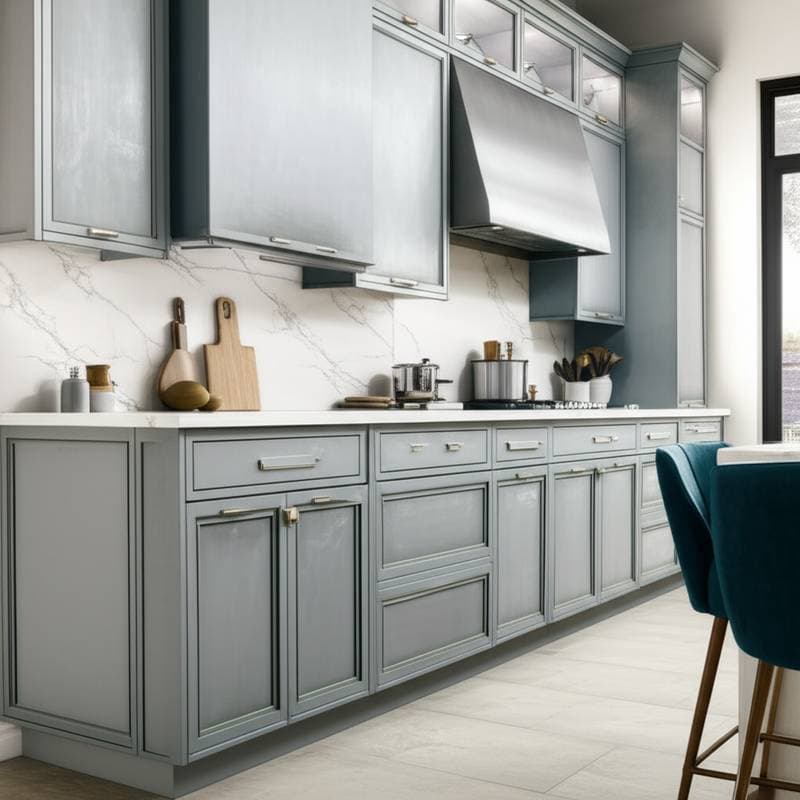Venetian Plaster: Elevate Cabinets Beyond Flat Finishes
Venetian plaster extends its legacy from architectural walls into cabinetry, offering woodworkers an innovative method to incorporate texture and dimension in areas once dominated by smooth coatings. Rather than applying standard stains or varnishes, professionals now use trowels to layer mineral-based plaster that interacts dynamically with light and encourages tactile interaction. This technique produces surfaces that evoke historical craftsmanship while delivering contemporary matte luminosity and exceptional endurance for routine handling.
Project Overview
Homeowner: Private residence
Location: Sonoma Valley, California
Size: 320 square feet (29.7 square meters) kitchen
Design Team: Lucia Grant Interiors
Cabinet Builder: Fairwood Custom Millwork
Photographer: Nathan Cole
Original Setup
The existing kitchen featured standard maple cabinets coated in a dark cherry stain. This finish appeared oppressive beneath the low ceiling, and the high-gloss overlay highlighted fingerprints prominently. While storage capacity met basic needs, the overall aesthetic felt cluttered and uninviting. Homeowner Erin James noted, "We wanted warmth without weight. Something tactile that still looked clean."
Renovated Result
The design team removed the upper cabinets and reconstructed the face frames using maple veneer panels, followed by the application of refined Venetian plaster in three precise layers with a steel trowel. This change altered the room's atmosphere completely. The gentle gray-beige plaster captured sunlight streaming through newly installed corner windows, while the inherent surface undulations eliminated the previous finish's uniform sheen. Flanking open oak shelves provided a harmonious contrast between the plaster's texture and natural wood grain.
Under-cabinet lighting now skims across the plaster, revealing nuanced tonal shifts that evolve with daily light patterns. Drawer fronts maintain a seamless profile, incorporating hidden pulls to direct attention toward the material's inherent qualities rather than visible hardware. Designer Lucia Grant explained, "We wanted it to feel like sculpted clay rather than cabinetry. The plaster adds depth and quiet character, and because it is mineral-based, it wears beautifully."
Technical Specifications
- Material Composition: Venetian plaster applied over maple veneer, formulated with lime and marble dust. Protected by a breathable wax coating for easy maintenance and resistance to moisture.
- Color Selection: A bespoke blend of soft greige infused with warm taupe undertones, selected to harmonize with oak flooring and brass hardware elements.
- Illumination Strategy: Integrated LED strips beneath shelves, recessed ceiling fixtures, and a single island pendant to accentuate the texture from diverse angles throughout the space.
- Edge Treatments: Corners softened with a light bevel for an authentic handcrafted appearance. Cabinet doors exhibit deliberate trowel impressions that contribute to the overall visual rhythm.
- Care Instructions: Wipe surfaces with a damp microfiber cloth; avoid chemical solvents. The protective wax withstands minor spills and requires renewal once per year to preserve integrity.
Reasons for Success
Venetian plaster introduces a sensory contrast to the sleek planes of countertops and appliances. Its yielding, uneven texture modulates light absorption across individual panels, fostering subtle diversity over expansive areas. In contrast to paints or stains prone to chipping or discoloration over time, lime-based plaster develops an appealing patina that enhances with age. Woodshops benefit from this method as it expands creative options without necessitating alterations to established cabinet fabrication processes.
Fairwood Custom Millwork indicates that the plaster layer increases door thickness by less than one-sixteenth of an inch, allowing compatibility with conventional hinges. Additionally, the material effectively conceals small seams between joints, creating the effect of seamless, solid slabs. For customers desiring bespoke craftsmanship, this finish connects the realms of high-end furniture and decorative mural work, blending functionality with artistic expression.
To further illustrate its versatility, consider how the plaster's mineral composition resists humidity fluctuations common in kitchen environments, outperforming organic finishes in longevity. Workshops can experiment with varying trowel pressures during application to achieve customized levels of smoothness or relief, tailoring the outcome to specific design visions. This adaptability makes Venetian plaster suitable not only for full cabinet resurfacing but also for accent panels or integrated architectural elements.
Implementation Guide for Woodshops
- Surface Preparation and Priming: Sand the veneer or MDF to a fine smoothness, then coat with a specialized mineral primer to promote strong adhesion and prevent delamination.
- Application in Layers: Employ a flexible steel trowel to apply each coat sparingly, allowing complete drying between applications. Typically, two to three layers build sufficient depth while minimizing the risk of cracks or uneven settling.
- Finishing Touches: After full curing, burnish the surface gently using the trowel's edge or a soft cloth to uncover a natural, subdued luster.
- Final Protection: Apply a layer of natural beeswax or a dedicated matte sealer formulated for lime plasters to enhance cleanability and safeguard against everyday wear.
Creating small prototype panels beforehand enables precise evaluation of color outcomes and application techniques. Always factor in the intended lighting setup, since oblique illumination accentuates the plaster's subtle contours and variations most effectively. For optimal results, maintain consistent environmental conditions during curing, such as moderate humidity and temperatures between 65 and 75 degrees Fahrenheit, to ensure uniform drying.
Essential Insights
- Venetian plaster enhances cabinetry through inherent texture, extending beyond mere chromatic changes.
- This method suits veneer, MDF, or sealed solid wood substrates equally well.
- Multi-layered mineral applications deliver dimensionality, reduce visible smudges, and diffuse light with elegance.
- Integrate understated hardware and strategic illumination to emphasize the material's qualities.
- Apply in kitchens, bathrooms, or custom built-ins to introduce serene, engaging surfaces.
Sources
Design Team: Lucia Grant Interiors
Cabinet Builder: Fairwood Custom Millwork
Photographer: Nathan Cole
Venetian plaster on cabinetry converts standard woodworking into evocative, interactive elements that reward close examination. By opting for texture over conventional staining, projects achieve enduring warmth, superior resilience, and a signature aesthetic that resonates across eras.
